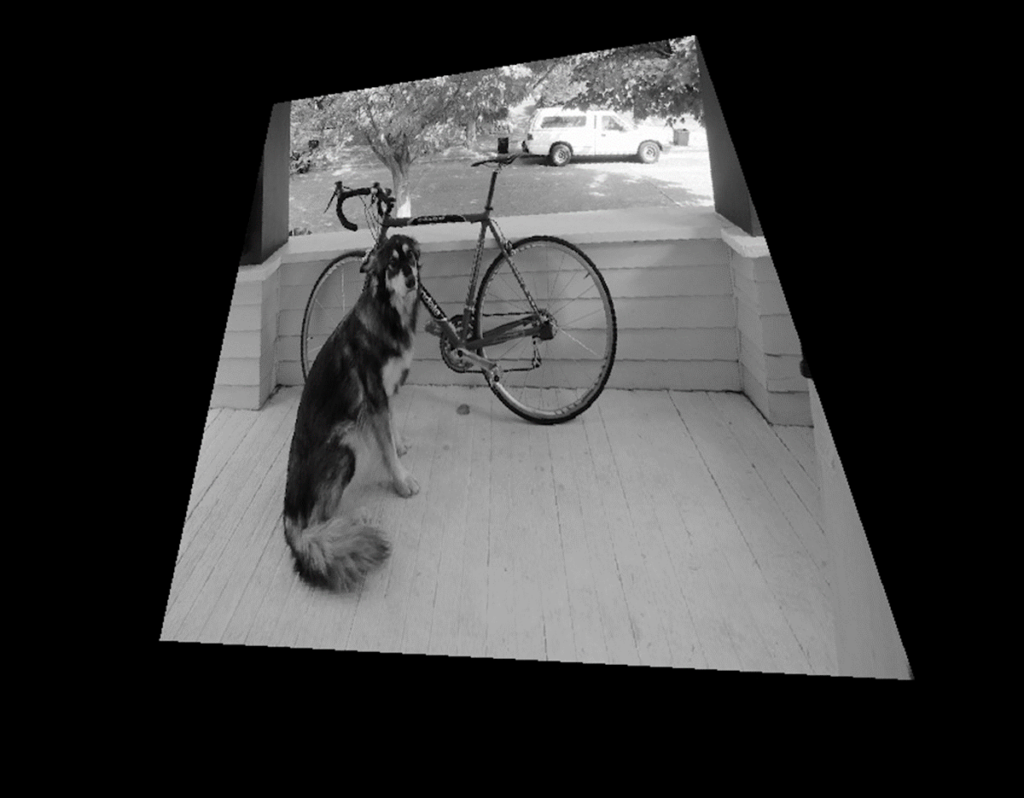MATLAB、Python、Scilab、Julia比較ページはこちら
https://www.simulationroom999.com/blog/comparison-of-matlab-python-scilab/
はじめに
の、
MATLAB,Python,Scilab,Julia比較 第3章 その101【射影変換⑮】
を書き直したもの。
アフィン変換の拡張と言われている射影変換の話。
実際にプログラムを組んでみる。
今回はScilabで実施。
【再掲】射影変換の処理の流れ
まずは処理の流れを再掲。
- 画像の読み込み
- 変換元座標の確定
- 変換先座標の確定
- \(a~h\)の算出
- 射影変換行列の確定
- 射影変換
- 画像保存
これをScilabで実現する。
Scilabコード
Scilabコードは以下になる。
canvas_expansion.sci
function img = canvas_expansion(img, x, y)
[H, W] = size(img);
WID = W+x;
HID = H+y;
e_img = uint8(zeros(HID, WID));
e_img(int32((HID-H)/2)+1:int32((HID+H)/2), int32((WID-W)/2)+1:int32((WID+W)/2)) = img;
img = e_img;
endfunctionhomography.sci
function homography_img= homography(img, homography_matrix)
// 画像サイズ取得
[hight, width] = size(img);
// 中心を0とした座標系を生成
x_axis = linspace(-1, 1, width);
y_axis = linspace(-1, 1, hight);
[xim,yim] = meshgrid(x_axis, y_axis);
// 座標x,y,1の3次元ベクトルの配列
// n(:)表記で列ベクトル化したあとに転置して行ベクトル化
points = [xim(:)';yim(:)'; ones(1, size(xim(:),1))];
// 変換元座標算出(射影逆変換)
points_affine = homography_matrix * points;
// 画像と同一形状の2次元配列に変換元座標配列を生成
dx = matrix(points_affine(1,:),[hight width]);
dy = matrix(points_affine(2,:),[hight width]);
ds = matrix(points_affine(3,:),[hight width]);
dx = dx./ds;
dy = dy./ds;
// 変換元座標をピクセル位置に変換
v = uint32(fix(min(max((dx+1)*width/2, 1), width )));
h = uint32(fix(min(max((dy+1)*hight/2, 1), hight )));
// 元画像と変換元座標を元に変換先へコピー
homography_img = matrix(img(h+(v-1)*hight),[hight width]);
endfunctionhomography_toTrape_test.sci
function homography_toTrape_test()
//stacksize('max');
img = imread('dog.jpg');
r = img(:,:,1);
g = img(:,:,2);
b = img(:,:,3);
// SDTVグレースケール
img = uint8([0.2990 * double(r) ...
+ 0.5870 * double(g) + 0.1140 * double(b) ]);
img = canvas_expansion(img, 100, 100);
x0=-1; y0=-1; // 左上
x1=-1; y1= 1; // 左下
x2= 1; y2= 1; // 右下
x3= 1; y3=-1; // 右上
x0t=-0.5; y0t=-0.8; // 左上変換先
x1t=-0.8; y1t= 0.8; // 左下変換先
x2t= 1; y2t= 1; // 右下変換先
x3t= 0.4; y3t=-1; // 右上変換先
mat = [x0, y0, 1, 0, 0, 0, -x0*x0t, -y0*x0t;
0, 0, 0, x0, y0, 1, -x0*y0t, -y0*y0t;
x1, y1, 1, 0, 0, 0, -x1*x1t, -y1*x1t;
0, 0, 0, x1, y1, 1, -x1*y1t, -y1*y1t;
x2, y2, 1, 0, 0, 0, -x2*x2t, -y2*x2t;
0, 0, 0, x2, y2, 1, -x2*y2t, -y2*y2t;
x3, y3, 1, 0, 0, 0, -x3*x3t, -y3*x3t;
0, 0, 0, x3, y3, 1, -x3*y3t, -y3*y3t];
xfer = [x0t, y0t, x1t, y1t, x2t, y2t, x3t, y3t]';
res = inv(mat)*xfer;
homo_matrix = inv([ res(1) res(2) res(3);
res(4) res(5) res(6);
res(7) res(8), 1]);
homography_img = homography(img, homo_matrix);
// グレースケール画像の書き込み
imwrite(homography_img/255, 'dog_homography_toTrapezoid.jpg');
endfunction処理結果
処理結果は以下。

考察
これも動作はOK。
そして、射影変換の\(s\)についての解決は以下のコードになる。
ds = matrix(points_affine(3,:),[hight width]);
dx = dx./ds;
dy = dy./ds;これもアフィン変換の使い回しでほぼOKな状態となる。
まとめ
- Scilabで射影変換実施。
- 基本的にはMATLABと一緒で、射影変換のsを解決するコードを追加すればOK。
MATLAB、Python、Scilab、Julia比較ページはこちら





コメント